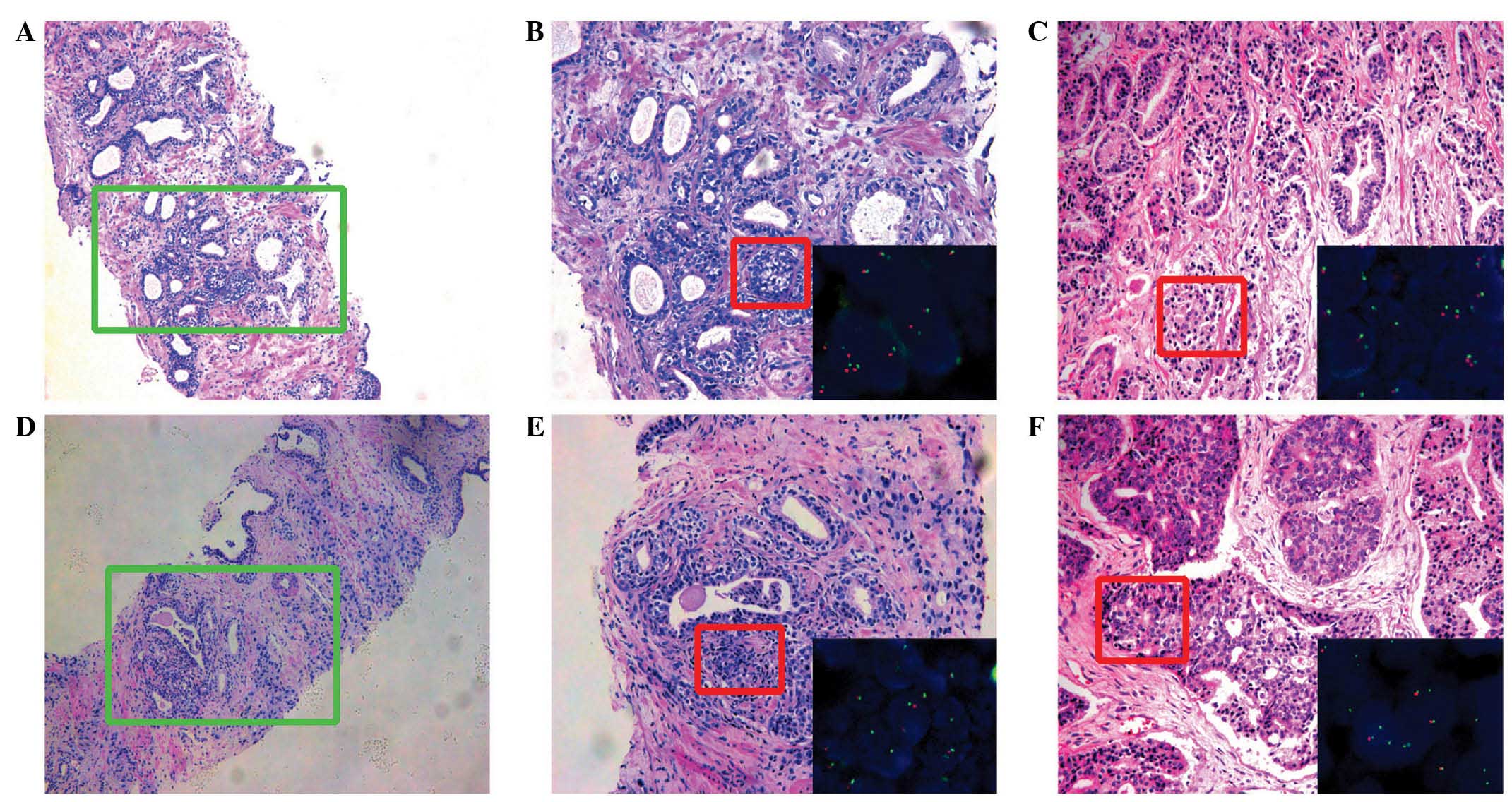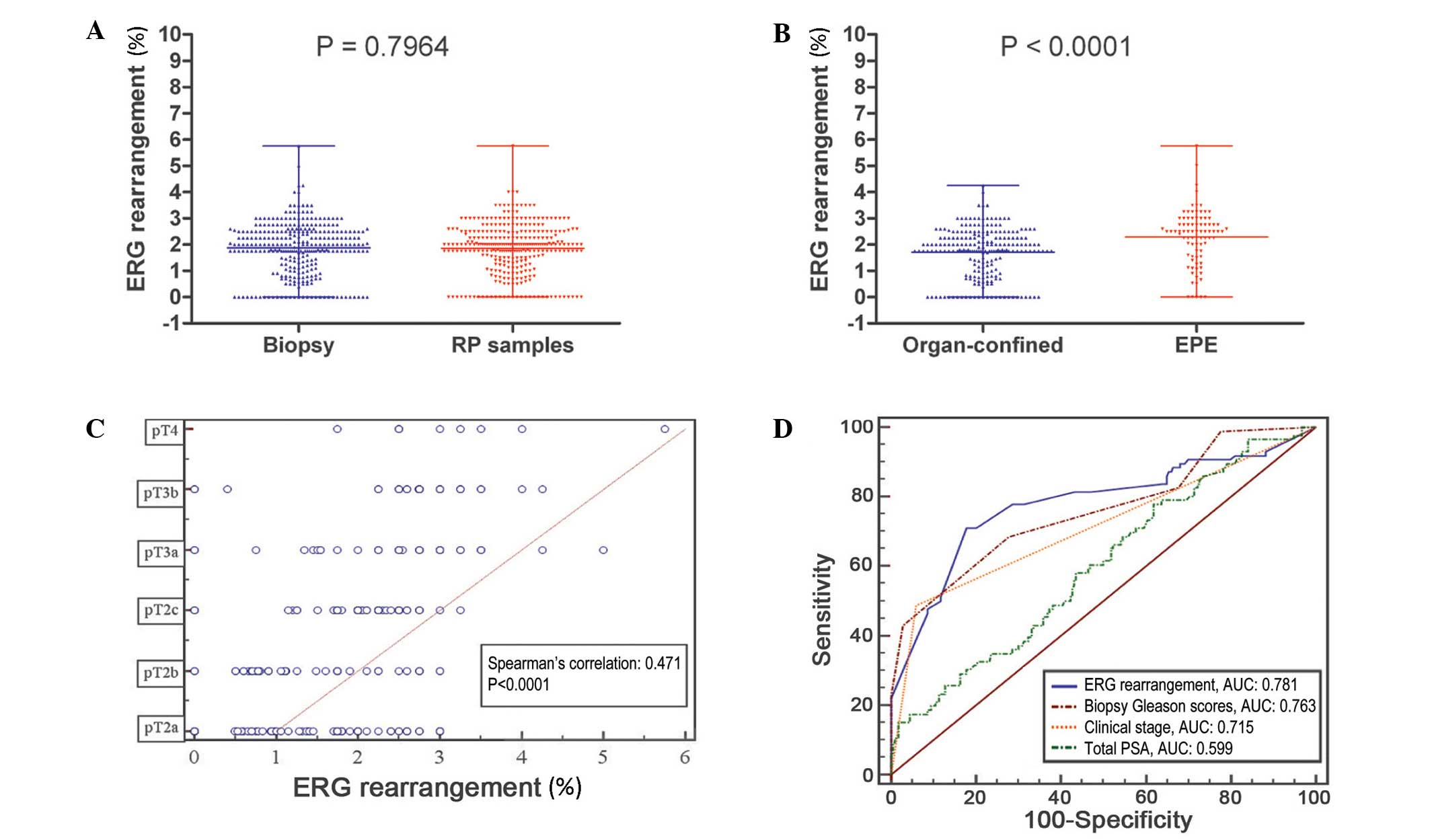|
1
|
Siegel R, Naishadham D and Jemal A: Cancer
statistics, 2013. CA Cancer J Clin. 63:11–30. 2013. View Article : Google Scholar : PubMed/NCBI
|
|
2
|
Heidenreich A, Bellmunt J, Bolla M, Joniau
S, Mason M, Matveev V, Mottet N, Schmid HP, van der Kwast T, Wiegel
T and Zattoni F: European Association of Urology: EAU guidelines on
prostate cancer. Part 1: Screening, diagnosis and treatment of
clinically localised disease. Eur Urol. 59:61–71. 2011. View Article : Google Scholar : PubMed/NCBI
|
|
3
|
Eifler JB, Feng Z, Lin BM, Partin MT,
Humphreys EB, Han M, Epstein JI, Walsh PC, Trock BJ and Partin AW:
An updated prostate cancer staging nomogram (Partin tables) based
on cases from 2006 to 2011. BJU Int. 111:22–29. 2013. View Article : Google Scholar : PubMed/NCBI
|
|
4
|
Hull GW, Rabbani F, Abbas F, Wheeler TM,
Kattan MW and Scardino PT: Cancer control with radical
prostatectomy alone in 1,000 consecutive patients. J Urol.
167:528–534. 2002. View Article : Google Scholar : PubMed/NCBI
|
|
5
|
Masieri L, Minervini A, Vittori G,
Lanciotti M, Lanzi F, Lapini A, Carini M and Serni S: The role of
free to total PSA ratio in prediction of extracapsular tumor
extension and biochemical recurrence after radical prostatectomy in
patients with PSA between 4 and 10 ng/ml. Int Urol Nephrol.
44:1031–1038. 2012. View Article : Google Scholar : PubMed/NCBI
|
|
6
|
Magi-Galluzzi C, Evans AJ, Delahunt B,
Epstein JI, Griffiths DF, van der Kwast TH, Montironi R, Wheeler
TM, Srigley JR, Egevad LL and Humphrey PA: ISUP Prostate:
International society of urological pathology (ISUP) consensus
conference on handling and staging of radical prostatectomy
specimens. Working group 3: Extraprostatic extension,
lymphovascular invasion and locally advanced disease. Mod Pathol.
24:26–38. 2011. View Article : Google Scholar : PubMed/NCBI
|
|
7
|
van Veggel BA, van Oort IM, Witjes JA,
Kiemeney LA and de Hulsbergen-van Kaa CA: Quantification of
extraprostatic extension in prostate cancer: Different parameters
correlated to biochemical recurrence after radical prostatectomy.
Histopathology. 59:692–702. 2011. View Article : Google Scholar : PubMed/NCBI
|
|
8
|
Roethke MC, Lichy MP, Kniess M, Werner MK,
Claussen CD, Stenzl A, Schlemmer HP and Schilling D: Accuracy of
preoperative endorectal MRI in predicting extracapsular extension
and influence on neurovascular bundle sparing in radical
prostatectomy. World J Urol. 31:1111–1116. 2013. View Article : Google Scholar : PubMed/NCBI
|
|
9
|
Eisenberg ML, Cowan JE, Davies BJ, Carroll
PR and Shinohara K: The importance of tumor palpability and
transrectal ultrasonographic appearance in the contemporary
clinical staging of prostate cancer. Urol Oncol. 29:171–176. 2011.
View Article : Google Scholar : PubMed/NCBI
|
|
10
|
Schwartz DJ, Sengupta S, Hillman DW,
Sargent DJ, Cheville JC, Wilson TM, Mynderse LA, Choo R and Davis
BJ: Prediction of radial distance of extraprostatic extension from
pretherapy factors. Int J Radiat Oncol Biol Phys. 69:411–418. 2007.
View Article : Google Scholar : PubMed/NCBI
|
|
11
|
Brassell SA, Kao TC, Sun L and Moul JW:
Prostate-specific antigen versus prostate-specific antigen density
as predictor of tumor volume, margin status, pathologic stage and
biochemical recurrence of prostate cancer. Urology. 66:1229–1233.
2005. View Article : Google Scholar : PubMed/NCBI
|
|
12
|
Magheli A, Rais-Bahrami S, Trock BJ,
Humphreys EB, Partin AW, Han M and Gonzalgo ML: Prostate specific
antigen versus prostate specific antigen density as a
prognosticator of pathological characteristics and biochemical
recurrence following radical prostatectomy. J Urol. 179:1780–1784,
1784; discussion. 2008. View Article : Google Scholar : PubMed/NCBI
|
|
13
|
Kumar-Sinha C, Tomlins SA and Chinnaiyan
AM: Recurrent gene fusions in prostate cancer. Nat Rev Cancer.
8:497–511. 2008. View
Article : Google Scholar : PubMed/NCBI
|
|
14
|
Tomlins SA, Bjartell A, Chinnaiyan AM,
Jenster G, Nam RK, Rubin MA and Schalken JA: ETS gene fusions in
prostate cancer: From discovery to daily clinical practice. Eur
Urol. 56:275–286. 2009. View Article : Google Scholar : PubMed/NCBI
|
|
15
|
Clark JP and Cooper CS: ETS gene fusions
in prostate cancer. Nat Rev Urol. 6:429–439. 2009. View Article : Google Scholar : PubMed/NCBI
|
|
16
|
Sun QP, Li LY, Chen Z, Pang J, Yang WJ,
Zhou XF, Qiu JG, Su ZL, He D and Gao X: Detection of TMPRSS2-ETS
fusions by a multiprobe fluorescence in situ hybridization assay
for the early diagnosis of prostate cancer: A pilot study. J Mol
Diagn. 12:718–724. 2010. View Article : Google Scholar : PubMed/NCBI
|
|
17
|
Gao X, Li LY, Zhou FJ, Xie KJ, Shao CK, Su
ZL, Sun QP, Chen MK, Pang J, Zhou XF, et al: ERG rearrangement for
predicting subsequent cancer diagnosis in high-grade prostatic
intraepithelial neoplasia and lymph node metastasis. Clin Cancer
Res. 18:4163–4172. 2012. View Article : Google Scholar : PubMed/NCBI
|
|
18
|
Tomlins SA, Rhodes DR, Perner S,
Dhanasekaran SM, Mehra R, Sun XW, Varambally S, Cao X, Tchinda J,
Kuefer R, et al: Recurrent fusion of TMPRSS2 and ETS transcription
factor genes in prostate cancer. Science. 310:644–648. 2005.
View Article : Google Scholar : PubMed/NCBI
|
|
19
|
Sobin LH, Gospodarowicz MK and Wittekind
C: TNM Classification of Malignant Tumours (7th). Wiley-Blackwell.
Hoboken, NJ: 2010.
|
|
20
|
Epstein JI: An update of the Gleason
grading system. J Urol. 183:433–440. 2010. View Article : Google Scholar : PubMed/NCBI
|
|
21
|
Epstein JI, Partin AW, Sauvageot J and
Walsh PC: Prediction of progression following radical
prostatectomy. A multivariate analysis of 721 men with long-term
follow-up. Am J Surg Pathol. 20:286–292. 1996. View Article : Google Scholar : PubMed/NCBI
|
|
22
|
Sakr WA, Wheeler TM, Blute M, Bodo M,
Calle-Rodrigue R, Henson DE, Mostofi FK, Seiffert J, Wojno K and
Zincke H: Staging and reporting of prostate cancer-sampling of the
radical prostatectomy specimen. Cancer. 78:366–368. 1996.
View Article : Google Scholar : PubMed/NCBI
|
|
23
|
Yu JB, Makarov DV, Sharma R, Peschel RE,
Partin AW and Gross CP: Validation of the partin nomogram for
prostate cancer in a national sample. J Urol. 183:105–111. 2010.
View Article : Google Scholar : PubMed/NCBI
|
|
24
|
Karakiewicz PI, Bhojani N, Capitanio U,
Reuther AM, Suardi N, Jeldres C, Pharand D, Péloquin F, Perrotte P,
Shariat SF and Klein EA: External validation of the updated Partin
tables in a cohort of North American men. J Urol. 180:898–902;
discussion 902–903. 2008. View Article : Google Scholar : PubMed/NCBI
|
|
25
|
Pepe P, Fraggetta F, Galia A and Aragona
F: Is PCA3 score useful in preoperative staging of a single
microfocus of prostate cancer diagnosed at saturation biopsy? Urol
Int. 89:143–147. 2012. View Article : Google Scholar : PubMed/NCBI
|
|
26
|
Xu B, Chevarie-Davis M, Chevalier S,
Scarlata E, Zeizafoun N, Dragomir A, Tanguay S, Kassouf W, Aprikian
A and Brimo F: The prognostic role of ERG immunopositivity in
prostatic acinar adenocarcinoma: A study including 454 cases and
review of the literature. Hum Pathol. 45:488–497. 2014. View Article : Google Scholar : PubMed/NCBI
|
|
27
|
Hermans KG, van Marion R, van Dekken H,
Jenster G, van Weerden WM and Trapman J: TMPRSS2: ERG fusion by
translocation or interstitial deletion is highly relevant in
androgen-dependent prostate cancer, but is bypassed in late-stage
androgen receptor-negative prostate cancer. Cancer Res.
66:10658–10663. 2006. View Article : Google Scholar : PubMed/NCBI
|
|
28
|
Perner S, Demichelis F, Beroukhim R,
Schmidt FH, Mosquera JM, Setlur S, Tchinda J, Tomlins SA, Hofer MD,
Pienta KG, et al: TMPRSS2: ERG fusion-associated deletions provide
insight into the heterogeneity of prostate cancer. Cancer Res.
66:8337–8341. 2006. View Article : Google Scholar : PubMed/NCBI
|
|
29
|
Attard G, Clark J, Ambroisine L, Fisher G,
Kovacs G, Flohr P, Berney D, Foster CS, Fletcher A, Gerald WL, et
al: Duplication of the fusion of TMPRSS2 to ERG sequences
identifies fatal human prostate cancer. Oncogene. 27:253–263. 2008.
View Article : Google Scholar : PubMed/NCBI
|
|
30
|
Hofer MD, Kuefer R, Maier C, Herkommer K,
Perner S, Demichelis F, Paiss T, Vogel W, Rubin MA and Hoegel J:
Genome-wide linkage analysis of TMPRSS2-ERG fusion in familial
prostate cancer. Cancer Res. 69:640–646. 2009. View Article : Google Scholar : PubMed/NCBI
|
|
31
|
Rajput AB, Miller MA, De Luca A, Boyd N,
Leung S, Hurtado-Coll A, Fazli L, Jones EC, Palmer JB, Gleave ME,
et al: Frequency of the TMPRSS2: ERG gene fusion is increased in
moderate to poorly differentiated prostate cancers. J Clin Pathol.
60:1238–1243. 2007. View Article : Google Scholar : PubMed/NCBI
|
|
32
|
Pettersson A, Graff RE, Bauer SR, Pitt MJ,
Lis RT, Stack EC, Martin NE, Kunz L, Penney KL, Ligon AH, et al:
The TMPRSS2: ERG rearrangement, ERG expression and prostate cancer
outcomes: A cohort study and meta-analysis. Cancer Epidemiol
Biomarkers Prev. 21:1497–1509. 2012. View Article : Google Scholar : PubMed/NCBI
|
|
33
|
Furusato B, van Leenders GJ, Trapman J,
Kimura T, Egawa S, Takahashi H, Furusato M, Visakorpi T and Hano H:
Immunohistochemical ETS-related gene detection in a Japanese
prostate cancer cohort: Diagnostic use in Japanese prostate cancer
patients. Pathol Int. 61:409–414. 2011. View Article : Google Scholar : PubMed/NCBI
|
|
34
|
Paulo P, Barros-Silva JD, Ribeiro FR,
Ramalho-Carvalho J, Jerónimo C, Henrique R, Lind GE, Skotheim RI,
Lothe RA and Teixeira MR: FLI1 is a novel ETS transcription factor
involved in gene fusions in prostate cancer. Genes Chromosomes
Cancer. 51:240–249. 2012. View Article : Google Scholar : PubMed/NCBI
|
|
35
|
Minner S, Enodien M, Sirma H, Luebke AM,
Krohn A, Mayer PS, Simon R, Tennstedt P, Müller J, Scholz L, et al:
ERG status is unrelated to PSA recurrence in radically operated
prostate cancer in the absence of antihormonal therapy. Clin Cancer
Res. 17:5878–5888. 2011. View Article : Google Scholar : PubMed/NCBI
|
|
36
|
Partin AW, Kattan MW, Subong EN, Walsh PC,
Wojno KJ, Oesterling JE, Scardino PT and Pearson JD: Combination of
prostate-specific antigen, clinical stage and Gleason score to
predict pathological stage of localized prostate cancer. A
multi-institutional update. JAMA. 277:1445–1451. 1997. View Article : Google Scholar : PubMed/NCBI
|
|
37
|
Huang Y, Isharwal S, Haese A, Chun FK,
Makarov DV, Feng Z, Han M, Humphreys E, Epstein JI, Partin AW and
Veltri RW: Prediction of patient-specific risk and percentile
cohort risk of pathological stage outcome using continuous
prostate-specific antigen measurement, clinical stage and biopsy
Gleason score. BJU Int. 107:1562–1569. 2011. View Article : Google Scholar : PubMed/NCBI
|
|
38
|
Paquette EL, Connelly RR, Sun L, Paquette
LR and Moul JW: Predictors of extracapsular extension and positive
margins in African American and white men. Urol Oncol. 21:33–38.
2003. View Article : Google Scholar : PubMed/NCBI
|
|
39
|
Nishimoto K, Nakashima J, Hashiguchi A,
Kikuchi E, Miyajima A, Nakagawa K, Ohigashi T, Oya M and Murai M:
Prediction of extraprostatic extension by prostate specific antigen
velocity, endorectal MRI and biopsy Gleason score in clinically
localized prostate cancer. Int J Urol. 15:520–523. 2008. View Article : Google Scholar : PubMed/NCBI
|
|
40
|
Giannarini G, Scott CA, Moro U, Pertoldi
B, Beltrami CA and Selli C: Are PSA density and PSA density of the
transition zone more accurate than PSA in predicting the
pathological stage of clinically localized prostate cancer? Urol
Oncol. 26:353–360. 2008. View Article : Google Scholar : PubMed/NCBI
|
|
41
|
Lin S, Zhang Q, Li P, Li Z, Sun Y, Shao Y,
Zhang X and Fu S: Prediction of extraprostatic extension in
patients with clinically organ-confined prostate cancer. Urol Int.
92:282–8. 2014. View Article : Google Scholar : PubMed/NCBI
|
















